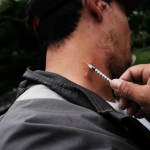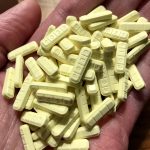Can You Shoot Xanax?

Injecting drugs, commonly known as “intravenous drug use” or “IV drug use,” is a common way people abuse illicit drugs or even legal prescription drugs. An injection like this is typically (or ideally) done into the vein, but injecting drugs just under the skin, often called “skin popping,” is also becoming popular. Users may also miss a vein and end up injecting a drug into the muscle.
Injection drug use is on the rise in the USA, and skin and soft tissue infections (SSTI) are a common complication, resulting in significant morbidity and mortality. This method is often preferred to ingesting a drug orally due to the fact that injecting a substance gets it to the brain much faster. Taking something orally means that the user must wait for the substance to be digested and absorbed through the intestines before it can get to the brain. This causes the drug to spread out in the system and take significantly longer to produce effects, resulting in a longer but less intense high.
An injected drug, however, needs only to pass through the heart and respiratory system before the oxygenated blood is sent to the brain. This process only takes a couple minutes, and the drug mostly arrives at the brain all at once. This produces what is commonly referred to as a “rush” – an intense feeling of euphoria that may only last for a few seconds before it levels out into the standard high, which is over after around 15-20 minutes. Drug users who prefer injection are therefore much more likely to engage in bingeing behavior, taking more doses immediately after the high wears off.
What is Xanax?
Xanax is the brand name for Pfizer’s brand of Alprazolam, a short-acting tranquilizer of the triazolobenzodiazepine class, which are benzodiazepines fused with a triazole ring. Pfizer is an American multinational pharmaceutical and biotechnology corporation headquartered in Manhattan, New York City.
Xanax works by decreasing abnormal excitement in the brain. The Food and Drug Administration (FDA) approved it in October 1981. Benzodiazepines act on the brain and central nervous system (CNS) to produce a calming effect. Xanax is a federal controlled substance (C-IV) because it can be abused or lead to dependence. Keep this medicine in a safe place to prevent misuse and abuse. Selling or giving away Xanax may harm others, and is against the law. Tell your healthcare provider if you have abused or been dependent on alcohol, prescription medicines or street drugs.
What does Xanax do?
Xanax slows down the movement of brain chemicals that may have become unbalanced, resulting in a reduction in nervous tension and anxiety. Xanax works by boosting the effects of a natural chemical called gamma-aminobutyric acid, which is made in the brain. Xanax is used to treat anxiety disorders and anxiety caused by depression. Xanax is also used to treat panic disorders with or without a fear of places and situations that might cause panic, helplessness, or embarrassment (agoraphobia).
Can you shoot Xanax?
No, you should never shoot or inject Xanax or any other oral prescription medication because it can have devastating consequences including instant death. In addition, people who inject drugs are among the groups most vulnerable to HIV infection. It is estimated that people who inject drugs are 22 times more likely to acquire HIV than among the rest of the population.
Injection drug users have other unique challenges because of additional social stigma, substantially increased risk for infectious diseases, the health consequences of injection drug use, and the addiction to the injection process itself. Needle fixation is when people become addicted not only to the drug, but also to the ritual of drawing their drug up into a needle, and the act of injecting it.
Why do people Inject Drugs?
For someone who isn’t addicted to drugs, it can be difficult to imagine why someone would inject drugs in the first place. However, for frequent drug users, it is a no-brainer.
When you swallow a pill, it can take from 15 minutes to one hour for the drug to take effect. When you crush and snort a pill, on the other hand, the effects occur much faster. IV drug use is the fastest way to feel the effects of a substance and the effects tend to feel much stronger, too.
Someone who has been abusing opioids for several years may begin using the drug by swallowing pills. After a few months, they may notice their tolerance increasing, causing them to use more and more pills. However, prescription opioid addiction is a costly habit, so many users will begin crushing and snorting the drugs to produce a stronger, faster high.
Then, after snorting drugs for some time, a person’s tolerance will continue to increase. They may desperately seek out another way to achieve the same high they have achieved in the past. As a result, some drug users turn to shooting up because it produces a rapid and potent high.
How to tell if someone is shooting up Xanax
Beyond Xanax, there are many different types of drugs that people inject and their behaviors while under the influence of these drugs may vary. For example, someone who injects heroin may appear sleepy and tired while someone who injects meth will appear energized and alert.
However, there are many physical signs of IV drug use that will let you know someone is shooting up.
Common physical signs of shooting up include:
• Track marks on arms – One of the easiest ways to tell if someone is shooting up is to look for evidence of IV drug use on their arms. If someone has been injecting drugs, they will have sores, scars, or track marks on their forearm. Track marks can also appear on the feet, toes, legs, hands, or neck. Drug users may also wear long-sleeve clothing to try and hide their track mark scars.
• Paraphernalia related to IV drug use – People who shoot up will usually keep a small bag or box containing items used to inject substances. These items may include a lighter, spoon, cotton, needle, and syringe.
• Skin infections – IV drug users may share needles with other people, reuse old needles, use dirty needles, or fail to practice sanitary injection techniques in general. In addition, they may repeatedly shoot up in the same place on their body. This can lead to skin infections that appear in the form of redness, irritation, abscesses, and more.
• Skin popping – Some drug users will inject drugs into their muscles rather than their veins. This can lead to a condition known as skin popping. Skin popping occurs when lumps form in the injection area when scar tissue starts to accumulate.
• Damage to veins – Frequent injecting, especially with dull needles, can cause veins to become scarred or even collapse. This is because drug users may fail to give their veins time to heal. Vein damage may appear as a painful bruise under the skin.
There are also behavioral signs to keep an eye out for as well. Keep in mind that these symptoms may also apply to snorting or smoking drugs as well as injecting.
• Weight loss or weight gain as a result of drug use
• Malnutrition
• Changes in sleeping patterns
• Appetite changes
• Mood swings and problems with mental health.





